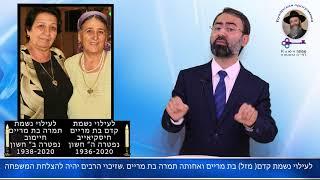Problems playing the video? Click Here to reload
Watch Videos: Random | New | Popular
All Essays | Report Video
|
Share Video
- Buy Us a Coffee -
Rabbi YY Jacobson
The Legal and Spiritual Difference between the Arm & Head Tefillin
For Source Sheets: https://www.theyeshiva.net/jewish/2659
The question is obvious: Why the change in the blessing before the tefilin we wrap on the arm and the one we place on our head? Why does the arm tefilin get the blessing “to put on tefilin,” and the head tefilin, “for the mitzvah of tefilin?” Both tefilins are put on, and both of them are a mitzvah! So why this distinction?
Rabbi Yosef Engel (1858-1920) and Rabbi Yosef Rozen (1858-1936), the Ragatchover Gaon, answer this question in a novel fashion. Take for example a bride getting dressed for her wedding. We all understand that the ultimate objective is not for her to put on the wedding gown; the objective is for her to be wearing the gown. It is just that in order to wear the gown, she needs to put it on. Is the same true about tefilin? Is the mitzvah to have the tefilin on you (if even for a short while), or perhaps the mitzvah is simply to put them on? Which part of the two components makes you fulfill the mitzvah? Which one of the two is the ultimate objective? Is it the act or the result of the act? Is it the act of wrapping tefilin on your arm and head, or is it the result of the wrapping, namely, that you are wrapped by tefilin? Rabbi Engel and Rabbi Rosen prove that in each one of the two boxes of tefilin, the definition of the mitzvah is completely different.
Which brings us to the deeper question: Why this strange distinction mitzvah between the tefilin on the arm vs. the tefilin on the head? Why would G-d desire different things for the two tefilins we wear? Why two different objectives for the arm tefilin and head tefilin? It was the Lubavitcher Rebbe who explained the novel approach of the Ragatchover from a deeper psychological and spiritual perspective. Essentially the distinct definition of the mitzvah in each one of the tefilin boxes reflect the stunning path of Judaism toward living a serene, wholesome, happy and maximized life, in which we learn to create peace between the mind and the heart.
in English
The Legal and Spiritual Difference between the Arm & Head Tefillin
For Source Sheets: https://www.theyeshiva.net/jewish/2659
The question is obvious: Why the change in the blessing before the tefilin we wrap on the arm and the one we place on our head? Why does the arm tefilin get the blessing “to put on tefilin,” and the head tefilin, “for the mitzvah of tefilin?” Both tefilins are put on, and both of them are a mitzvah! So why this distinction?
Rabbi Yosef Engel (1858-1920) and Rabbi Yosef Rozen (1858-1936), the Ragatchover Gaon, answer this question in a novel fashion. Take for example a bride getting dressed for her wedding. We all understand that the ultimate objective is not for her to put on the wedding gown; the objective is for her to be wearing the gown. It is just that in order to wear the gown, she needs to put it on. Is the same true about tefilin? Is the mitzvah to have the tefilin on you (if even for a short while), or perhaps the mitzvah is simply to put them on? Which part of the two components makes you fulfill the mitzvah? Which one of the two is the ultimate objective? Is it the act or the result of the act? Is it the act of wrapping tefilin on your arm and head, or is it the result of the wrapping, namely, that you are wrapped by tefilin? Rabbi Engel and Rabbi Rosen prove that in each one of the two boxes of tefilin, the definition of the mitzvah is completely different.
Which brings us to the deeper question: Why this strange distinction mitzvah between the tefilin on the arm vs. the tefilin on the head? Why would G-d desire different things for the two tefilins we wear? Why two different objectives for the arm tefilin and head tefilin? It was the Lubavitcher Rebbe who explained the novel approach of the Ragatchover from a deeper psychological and spiritual perspective. Essentially the distinct definition of the mitzvah in each one of the tefilin boxes reflect the stunning path of Judaism toward living a serene, wholesome, happy and maximized life, in which we learn to create peace between the mind and the heart.
in English
- Category
- Tefillin - Тефиллин
- Tags
- refillin
Commenting disabled.
















